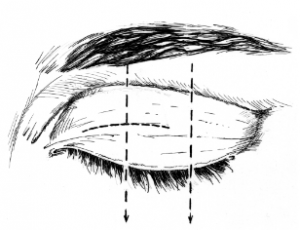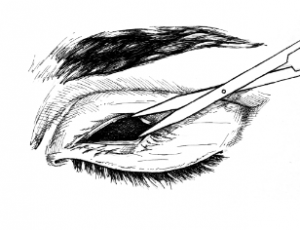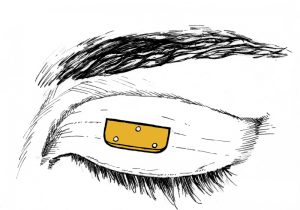Physician Information
Surgical Treatment
The optimum surgical treatment choice for reducing the risk of ocular exposure in the facial palsy patient has long been the implantation of an eyelid weight made from either 99.99% pure gold or pure platinum. MedDev’s sterile eyelid weight implants are provided for this purpose in two designs: Contour® Eyelid Weight Implants and ThinProfile® Eyelid Weight Implants.
Indications
The indication for use of MedDev eyelid weight implants is paralytic Lagophthalmos resulting from paralysis of the seventh facial nerve.
Treatment
A gold or platinum (99.99% purity) eyelid weight is implanted into the upper eyelid providing an immediate beneficial blink function to distribute tear film and protect the cornea.
Advantages of the procedure
- Clinically proven with a low rate of complications (a 92% reported surgical success rate1)
- Enhanced patient satisfaction and improved quality of life
- Straightforward procedure; relatively easy to learn
- Reversible procedure if normal eyelid function is regained
- May eliminate need for disfiguring tarsorrhaphy
Advantages of MedDev Eyelid Weight Implants
- Precisely tapered edges and smoothly rounded corners ensure tissue compatibility
- Spherically curved lower implant profile
- Microscopically-inspected, flawless implant surfaces
- Sterile, double-pouch packaging with peel-off surgery record labels
- 99% implant material purity
- Gold is the standard material that does not corrode or cause irritation to the eyelid tissue
- Platinum offers excellent biocompatibility and a higher specific gravity making it appropriate implant choice for gold sensitive patients.
- Implants are available in two designs and materials addressing specific patient needs.
- Patients with clinical characteristics of excessively thin upper eyelid skin with an associated increase in the risk of extrusion would benefit from ThinProfile’s reduced thickness (0.65 mm thickness).
- Excellent passive (gravity assisted) eyelid closure and a functional blink are achieved from use of the Contour eyelid implant design.
- Manufactured to exacting specifications
Surgical Technique
Weight Determination
The appropriate weight Eyelid Implant is determined by testing different weights from the MedDev Tantalum Eyelid Weight Sizing Set to the upper eyelid. The appropriate weight allows the eyelid to close without difficulty and induces a slight ptosis of no more than 1.0 mm, as the levator seems to strengthen after implantation.
Placement
Final placement of the Eyelid Implant may be septal, mid-pretarsal or low-pretarsal. Recognizing that surgical technique is a matter of individual surgeon preference, MedDev presents two representative techniques from Dr. Richard Jobe2 and Dr. Stuart Seiff3 respectively.
 |
 |
| Figure 1: Incision in Eyelid | Figure 2: Blunt Dissection |
Septal Fixation
Local or general anesthesia may be used. A 1.5 cm to 2.0 cm incision is made horizontally in the deep portion of the upper lid sulcus. The incision should be centered at the juncture of the medial and central thirds of the lid (Figure 1). It should be carried just through the orbicularis muscle fibers to the plane beneath the orbicularis.
By blunt dissection, the plane is opened to make room for the implant on the surface of the orbital septum and the tarsal plate (Figure 2). Usually, the Gold Eyelid Implant will rest more comfortably with its lower edge 4 to 5 mm above the lid margin (Figure 3a). The implant is placed with the rounded corners down. The implant is tied to the orbital septum with a single 6-0 non-absorbable suture to hold it in place until the tissues heal around it and through the suture holes. If the Gold Eyelid Implant does not sit comfortably parallel to the lid margin, then another suture should be placed.
The implant is placed a short distance above the lid margin so that it will not be evident in the thinnest portion of the lid. A slight bulge may nevertheless be visible.
The skin and orbicularis are closed by the method of the surgeon’s choice.
Septal Placement
 Figure 3a Septal Placement
Figure 3a Septal Placement
Pretarsal Fixation
Local or general anesthesia may be used. The lid crease is marked (Figure 1). A 4-0 black silk suture is placed near the upper lid margin to allow for downward traction. A blade is used to incise at the lid crease through skin and orbicularis. Scissors dissection is performed inferiorly into the pretarsal space (Figure 2). The levator aponeurosis is stripped from its attachments to tarsus in the area of planned implantation, thus baring the anterior tarsal surface and effecting a modest levator recession. Hemostasis is achieved. The previously selected Gold Eyelid Implant, which has been thoroughly cleaned and sterilized, is centered over the bare superior tarsal surface (Figure 3b). The implant is placed with the rounded corners down. Sutures are placed through the holes in the implant directly to the tarsus using 5-0 polyglactin sutures on spatula needles. Antibiotic solution is irrigated into the wound. Orbicularis is closed over the implant with interrupted 6-0 polyglactin sutures. The traction suture is removed and the skin is closed with a running 6-0 silk or nylon suture. Antibiotic ointment is placed over the wound and a double eye pad is applied.
Pretarsal Placement
 Figure 3b: Pretarsal Placement
Figure 3b: Pretarsal Placement
- Jobe, R. P. 1974. A technique for lid loading in the management of lagophthalmos of facial palsy. Plastic and Reconstructive Surgery, 53, 29-32.
- Seiff, S. R., Sullivan, J. H., Freeman, L. N. & Ahn, J. Pretarsal fixation of gold weights in facial nerve palsy. Ophthalmic Plastic and Reconstructive Surgery, 5, 104-1 09.
Sizing Information
The Tantalum Weight Sizing Set assists the physician in determining the appropriate weight size when selecting either a MedDev eyelid weight implant or a Blinkeze® External Lid Weight.
Benefits and Features
- Permits preoperative sizing
- Convenient and easy to use
- Reusable
- Reduces the investment for sizing patients with more expensive gold eyelid implants
- Clearly shows the patient that the treatment will be effective
- Produced from 99.9% tantalum with a polished finish
- Standard Set contains seven weights ranging from 0.6g to 1.8g in 0.2g increments
- Special Set contains five weights ranging from 2.0g to 2.8g in 0.2g increments
- Each set includes a box of 100 EyeClose Adhesive Strips, (LL 0505)
- Weights are organized in a convenient storage box
- Includes a skin tone selector card
Steps to find the correct weight
The appropriate weight for an eyelid implant or Blinkeze® External Lid Weight is determined by testing different weights on the upper eyelid using the Tantalum Eyelid Weight Sizing Set (Catalog# TEW7000/TEW7004):
- Follow instructions for placing a double-sided EyeClose® Adhesive Strip on the concave side of the 1.0 gm sizing weight.
-

Figure 1: Implant Placement With the patient sitting upright, secure the weight to the upper eyelid above the lash line, centered at the junction of the medial and central thirds of the eyelid (See Figure 1). At this point, extension of the levator function is maximal.
- Note the position of the eyelid as the patient looks up and down.
- Increase or decrease the sizing weight until the best result is achieved. Because the levator strengthens after the weight is added, the optimal weight causes a slight degree of ptosis (~1mm) during primary gaze that typically resolves within 1-2 months.
Non-Surgical Treatment
Blinkeze External Lid Weights (NOT FOR IMPLANTATION) provide an immediate, voluntary blink mechanism for treating ocular exposure associated with temporary facial paralysis such as Bell’s palsy. The weight simply uses gravity to gently close the upper eyelid when the patient looks down or relaxes the eyelid muscle.
MedDev offers Blinkeze External Lid Weights in a variety of skin tone colors to match a patient’s complexion. They are manufactured from 99.99% pure tantalum, a dense metal with high biocompatibility. The weight is provided in a treatment kit, which includes 100 double-sided hypoallergenic adhesive strips for attaching the weight, a mirror and detailed instructions.
Advantages of Blinkeze External Lid Weights
- Wearing a Blinkeze External Lid Weight prior to surgery reinforces patient confidence that the treatment will be effective.
- Reusable.
- Enhances facial appearance.
- Comfortable and easy to use.
- Simplifies supportive eye care by decreasing patient reliance on ophthalmic ointments and lubricants.
- Permits preoperative sizing and accurate weight selection for an eyelid weight implant if the condition persists.
- Non-invasive, immediate temporary treatment for the ocular exposure associated with facial paralysis.
Skin Tone Selection
The Tantalum Weight Sizing Set includes a Skin Tone Selector Card to determine the appropriate skin tone color that best approximates a patients’ eyelid complexion. Blinkeze External Lid Weights are available in five different colors: -0 Light; 1 Pink/Neutral; -2 Tan; -3 Medium Brown; and -4 Dark Brown. It is necessary to indicate the skin tone color when placing your order for a Blinkeze External Lid Weight.

(Note: The appearance of the skin-tone colors above may vary due to differences in browsers and computer monitors.)
Skin Tone Selector Cards are available free of charge by calling MedDev.
EyeClose® Double-sided Adhesive Strips
EyeClose Adhesive Strips are used to temporarily adhere Blinkeze External Lid Weights to the outside of the upper eyelid. EyeClose Adhesive Strips are a composite of white, semi-transparent film and fabric coated on both sides with a pressure sensitive hypoallergenic adhesive. Each EyeClose Adhesive Strip box contains ten sheets of ten, single-use double-sided strips (100 strips).
Reimbursement
The following are the specific CPT/HCFA codes that have been promulgated for this procedure:
CPT Procedure Codes
| Code | Description |
|---|---|
| 67912 | Correction of lagophthalmos with implantation of upper eyelid lid load (e.g., gold weight) |
Suggested HCPCS Level II (National) Supply Codes
| Code | Description |
|---|---|
| L8610 | Other prosthetic procedure devices - ocular |
| L8499 | Unlisted procedure for misc. prosthetic services |
Some commercial insurers prefer CPT 99070 (Supplies and materials provided by the physician over and above those usually included with the office visit or other services rendered) to HCPCS Level II codes.
CPT 99070
Modifiers
| Code | Description |
|---|---|
| 50 | Bilateral |
| 51 | Additional Procedure |
